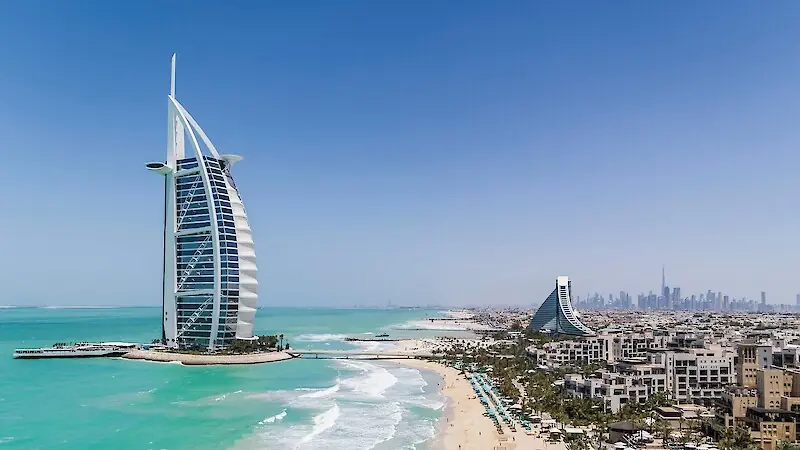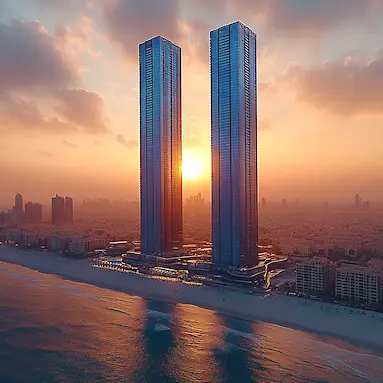From royal suites and underwater restaurants to golden iPads and personal butlers. We’ll tell you how to experience the legend and whether it’s worth it. Even those who’ve never been to Dubai recognize its sail-shaped silhouette. Burj Al Arab Jumeirah is a building that long ago ceased to be just a hotel and has become synonymous with the very word "luxury." Since its opening, it has accumulated so many myths that it unofficially earned "seven stars" and gained fame as a place where even the faucets come with usage instructions (gold for hot water, platinum for cold). But what’s true, and what’s just a beautiful legend? For most tourists, the "Sail" is merely a backdrop for selfies taken from the beach. A closed world accessible only to sheikhs and billionaires. But is that really the case? In this guide, we’ll crack the access code. I’ll not only reveal what lies behind the golden interiors but also share three perfectly real ways to get inside—and one of them won’t cost more than a nice dinner. Buckle up: we’re heading behind the facade of an architectural marvel that forever changed the world’s perception of luxury.
Beyond luxury: What’s hidden inside the "sail"
Once inside, you realize that the hotel’s exterior is just a prelude to the true magnificence. Burj Al Arab is a world where every detail is designed to amaze the imagination, from architectural solutions to the level of personalized service.
Architecture and records: how the legend was built
The story of Burj Al Arab is one of ambition. The hotel was constructed on an artificial island 280 meters from the shore, and its unique design features an external steel exoskeleton that supports the structure. The "sail" itself is covered with Teflon fabric, which radiates dazzling whiteness during the day and transforms into a giant screen for light shows at night. However, it wasn’t just engineering marvels that brought the hotel worldwide fame. The helipad located at a height of 212 meters became the setting for iconic events, including the legendary tennis match between Roger Federer and Andre Agassi, forever cementing the hotel’s place in pop culture history.
Luxury suites only: how the two-level apartments with a personal butler are designed
There are no "standard" rooms here—only 202 two-level suites, the smallest of which (170 sq.m.) exceeds the size of many city apartments. Instead of just one wall, you’ll find a panoramic window overlooking the bay. And instead of ordinary service, you’ll have a personal butler who silently unpacks your suitcase while you recover from your journey, and at night, if sleep eludes you, offers a choice of 17 different pillow types. Oh, and to control all this high-tech convenience, you won’t be handed just any tablet—you’ll receive an iPad coated in 24-karat gold, which somehow feels excessively heavy. Plus, in the bathroom, you won’t find sample-sized products, but full-size bottles of Hermès cosmetics.
Fact: Regarding the gold: nearly 1,800 square meters of genuine 24-karat gold leaf were used to decorate the hotel's interiors. It’s everywhere here—from columns to picture frames.

A gastronomic journey between sky and sea
The hotel's restaurants are attractions in their own right, each offering a unique experience.
- Al Mahara ("Oyster"): This is the very "underwater" restaurant that many guests come to the hotel specifically to visit. The journey to your table is an attraction in itself: you descend in an elevator designed to resemble a submarine. Then you dine surrounded by a giant aquarium, where rays and schools of exotic fish slowly glide past you behind thick glass. The sensation is truly surreal, especially when exquisite seafood delicacies are served on your plate, while their living counterparts swim just outside the window.
- Al Muntaha ("The Pinnacle"): Taking a high-speed elevator up to a height of 200 meters, you enter a space where the main course is the view. Through panoramic windows, you’re treated to a breathtaking panorama of the man-made Palm Jumeirah island and the glittering city lights below. This is a place where dinner accompanied by fine French cuisine transforms into a meditation on the grandeur of modern Dubai.
- Sahn Eddar: This lounge is located at the base of the world's tallest atrium, and you can feel it in every sound. You sit right at the heart of an architectural marvel, beneath vaulted ceilings soaring 180 meters high, where echoes of live classical music blend with the gentle murmur of fountains. It’s the perfect setting for the famous afternoon tea accompanied by gold-decorated desserts, allowing you to fully experience the grandeur and splendor of this place.
Tip: Even if you’re not a hotel guest, booking a table at one of the restaurants is your ticket inside. It’s the most popular way to see the legendary interiors without paying for a room.

Exclusive retreat: the terrace and Talise Spa
The Terrace is another engineering marvel—a luxurious deck built in Finland and shipped to Dubai by sea. Here, far from the hustle and bustle of the city, you’ll find two infinity pools (one with fresh water, the other with saltwater), a private beach with perfectly white sand, and a restaurant. It’s an oasis floating above the sea, where time slows down, and your only concern is remembering to bring your sunglasses.
For even deeper relaxation, be sure to visit Talise Spa. Spread across two floors, it offers not only exclusive treatments but also breathtaking views—imagine receiving a massage with a panoramic vista of the Arabian Gulf right from the treatment room.

Stay overnight or just drop by? Choosing your own way to experience the Burj Al Arab
So, how do you conquer this fortress of luxury? There are several paths, and you certainly don’t have to sell your family silver to do it. It all depends on your goals, budget, and level of curiosity. We’ve broken down three main scenarios—from "living like a sheikh" to "just popping in"—so you can pick the one that suits you best.
| Method of visit | Ideal for... | What you get | Price range |
|---|---|---|---|
| Hotel Stay (Full Immersion) | Those seeking uncompromising luxury and willing to pay for it. | Full access to all hotel areas, including The Terrace, personal butler services, and Rolls-Royce transfers. | $$$$$ (premium suite) |
| Gourmet Visit (Dinner, Lunch, or Tea) | Foodies and those who want to see the famous interiors without breaking the bank. | Access to the lobby and your chosen restaurant, plus the chance to take photos in iconic spots. | $$$ (premium) |
| "Inside Burj Al Arab" Tour | Curious tourists interested in architecture, design, and history. | A 90-minute guided tour of key locations, including the royal suite, which is off-limits to other visitors. | $$ (affordable premium) |
Your visit to Burj Al Arab: A practical guide
To ensure your visit goes smoothly, it's important to be aware of a few key rules and recommendations.
Booking — the key to exclusivity
It's impossible to spontaneously visit Burj Al Arab. Any visit, whether for accommodation, dining at the restaurant, or a tour, requires prior booking. Your confirmed reservation is your pass through the checkpoint on the bridge leading to the hotel. Especially during peak tourist season (October to April), we recommend planning your visit several weeks in advance.
Dress code and etiquette: how to match the moment
Remember the main rule at Burj Al Arab: you can't just drop by casually after the beach. The dress code here isn't a recommendation—it's a rule, and they enforce it more strictly than they monitor the purity of gold. To avoid ending your visit at the gate, familiarize yourself with these guidelines.
Important: dress code: Burj Al Arab has a strict dress code. Forget shorts, t-shirts, and beach footwear. Men must wear long trousers, a shirt (preferably with a collar), and closed-toe shoes. Women should opt for an elegant dress, skirt, or stylish pantsuit. Failure to comply with the rules may result in denied access, even with a paid reservation.
How to get there
- Taxi or Uber: The simplest and most popular option. The driver will take you directly to the entrance, where your reservation will be checked at the checkpoint.
- Private Car: Access to the island by private or rented car is only possible with a confirmed reservation.
- Rolls-Royce Phantom Transfer: An exclusive service available exclusively to hotel guests.
Price guide: how much does it cost to touch your dream?
Please note: prices are approximate and may vary depending on the season and exchange rates. Always check the current rates on the official website when booking.
- Accommodation: from ~$1,500 per night in the low season ($$$$$)
- Dinner (a la carte): on average $300–400 per person ($$$)
- Afternoon Tea: from ~$150 per person ($$$)
- "Inside Burj Al Arab" Tour: from ~$100 per person ($$)
Useful information about deposits: When booking a table at the restaurant, a deposit is often required, which is then deducted from your final bill. This guarantees your reservation and is standard practice for establishments of this caliber.
Verdict: Is Burj Al Arab worth its money and legends?
So, is it worth it? Absolutely. But the value of visiting Burj Al Arab today lies not in its ostentatious gold or seven stars. It’s an opportunity to step inside a time machine. To see the bold, almost audacious dream from which modern Dubai was born. To stand in the atrium that once seemed like an architectural marvel, and realize that it is precisely this self-confidence and gigantomania that continue to drive the entire emirate. And it doesn't matter whether you spend a hundred dollars or ten thousand—you'll take away with you the most important thing: a tangible sense of how one person's ambition can change not only the horizon but also the entire world's perception of luxury.























Comments